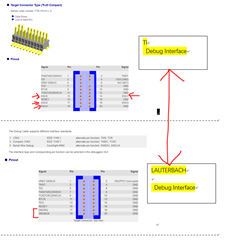Following diagram is for TI debug interface and LAUTERBACH debug interface.
All pins can be mapped to LAUTERBACH other than EMU1,2,3,4.
Question:how to connect EMU1,2,3,4 to LAUTERBACH? is there some document?

This thread has been locked.
If you have a related question, please click the "Ask a related question" button in the top right corner. The newly created question will be automatically linked to this question.
Following diagram is for TI debug interface and LAUTERBACH debug interface.
All pins can be mapped to LAUTERBACH other than EMU1,2,3,4.
Question:how to connect EMU1,2,3,4 to LAUTERBACH? is there some document?

Hello,
The cTI20 provides pins for JTAG, Power/Ground, trace, trigger and control signals. The cTI20's EMU0-4 signals can be used for control, trace, or trigger between a TDA4 and a Lauterbach debug system. The TI reference board/EVM uses a larger MIPI-60 connector which allows for all the trace signals (not just a subset) between the SOC and the debugger. To fully utilize all the signals for a Lauterbach system, multiple debug boxes would be needed. TI recommends the MIPI-60 for external trace as its dimensioning needed for high speed trace sources like the Cortex-A72. A narrow cTI20 interface can be useful for external STM trace+decode but it will have a lot of holes when used for faster sources.
For example if you only have a basic Lauterbach PowerDebug box, then the LB's ARM20 header only allows for JTAG and trigger signals (not external pin trace). A typical adaptor to use in this situation is a LA-3780 (ARM20 to cTI20, https://www.lauterbach.com/frames.html?product_information.php?info=la-3780 ). In this case you would only hook up the CPUs trigger/control EMU0 signals to the cTI's header EMU0, see the description here: https://www2.lauterbach.com/pdf/app_arm_jtag.pdf#page=25. You can see a cTI20 example in this lower end cousin SOC https://www.ti.com/lit/df/sprr432/sprr432.pdf?ts=1641420055379#page=25. This example hooks up both EMU0 and EMU1 as the TI-CCS debug box can use both triggers, but a Lauterbach box currently only supports EMU0 as a trigger.
To utilize external pin trace features you would need to have a PowerTRACE box (LA-7694) and preprocessor (LA-7992) in addition to the basic debug box (MIPI-60 recommended). To the cTI20's 5 EMUx signals to export pin trace, you would need to connect the TDA4's TRC_CLK and TRC_DATA0-3 up to the cTI20s EMUx signals then route those signals to the TRACE32 matching TRACE receiver signals. This is what happens for full width system which a MIPI-60 exports using up to 24 TRC_DATAx signals. See the documents and pinouts for these devies: https://www.lauterbach.com/frames.html?pro/pro_dra829v_alt03.php?chip=DRA829V
The cTI20's EMU trace pins are mostly suitable for a lower bandwidth source like a Cortex-M or an STM stream. Lauterbach provides the products like the CombiProbe and MicroTrace https://www.lauterbach.com/frames.html?cortexm_tools.html for this. These boxes 'can' be used with TDA4 (I have used) but they are constrained in usage.
You should check with Lauterbach and see what options they recommend with their tools. They do have TDA4 boards at their HQ and they do fully support debug over JTAG and hardware trace (internal or external). The bottom line is a cTI20 is mostly for JTAG debug and low speed trace commonly found on MCUs, it can be leveraged for some lift on higher end MPUs but the processes is not streamlined for that usage.
Regards,
Richard W.